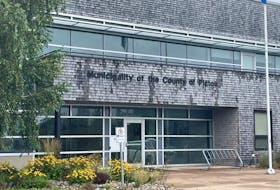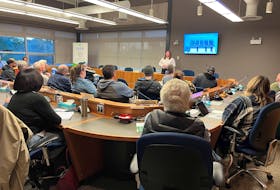PICTOU, N.S. — For gardeners who have seen their hard work trodden under hoof and devoured by deer, vengeance through a cull by bow hunters might sound like a just war to wage.
But Pictou County Warden Robert Parker doesn’t believe it’s a practical solution.
“It really doesn’t work,” he said, referring to other bounties that have been held in the past. “Those animals respond by having more young.”
The Municipality of Pictou County’s deputy clerk, Carolyn MacIntosh, had written a report at the request of council on what other municipalities in Nova Scotia are doing to address an increase in urban deer, and presented her findings to council on Sept. 16.
She said Truro appears to be the only municipality outside of Pictou County in Nova Scotia that has addressed the issue. In that town, they’ve been monitoring the deer population, and last fall opened a section of woods near the town's watershed area to bow hunters.
Other options that have been touted as possibilities include surgically sterilizing deer or using a form of birth control. Both are costly, however.
She said New Glasgow has also conducted a survey and is looking at how to address its large urban deer population.
MacIsaac said the municipality could consider implementing a bylaw banning people from feeding deer and also suggested the best option may be to provide residents with information to educate them on how to live with deer.
Coun. David Parker, who has a degree in wildlife biology, thanked MacIntosh for her research and said he agreed that education is the best solution.
David Parker said he believes there are several reasons for why the deer population seems to have ballooned in some sections.
He believes the problem began with large-scale forest harvesting in the 80s, 90s and early part of the 21st century, which has provided excellent habitation for deer near urban centres. He believes there are less hunters now and that the buck laws that are being implemented are archaic and only worsen the problem.
To top it off there is what he calls “the Bambi effect” which started with the Disney movie. “We believe that deer are beautiful and kind and thoughtful animals, etc., etc., – which they may well be,” David Parker said, “But they can also be a nuisance.”
He believes residents need to learn to live with the deer though.
“We have to realize that they’re here to stay and we have to learn to do whatever we can to reduce the damage to our property.”
Robert Parker, who operates a gardening business, said he now has many people who come into his business asking for what they can plant that deer won’t eat.
He believes it can become a safety issue because of the increased risk of hitting a deer with a car.
“We do have a lot of very bad accidents in the county. Usually they’re not fatal, but they’re certainly fatal to the car.”
He said he’s also heard of cases where a deer gets inside a gardener’s fence and when cornered, attacks.
Unsuccessful hunt
An archery hunt last fall in the Town of Truro watershed area did little to reduce the town’s growing deer population. Just two bow hunters hunters were successful in getting a deer, while 35 were not. That was based on the response of 37 of the 54 hunters who registered for the hunt.
RELATED LINKS:
Oh, deer: Pictou County's 'significant' deer problem
New Glasgow looking to analyze urban deer situation
Watershed bow hunt did little to decrease Truro's deer population

![['White-tailed deer first reached Cape Breton around 1911 and have lived here ever since.']](https://saltwire.imgix.net/CB-C03-13092017-deer-copy.jpg?cs=srgb&fit=crop&h=568&w=847&dpr=1&auto=compress%2Cformat%2Cenhance)







